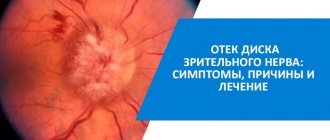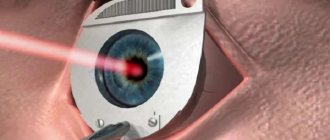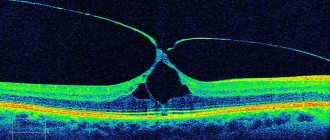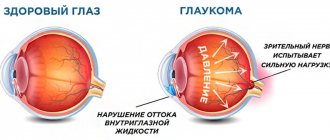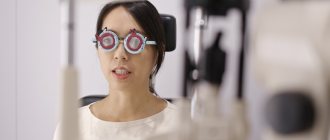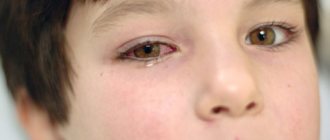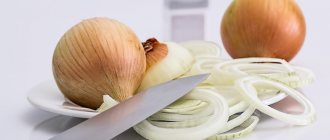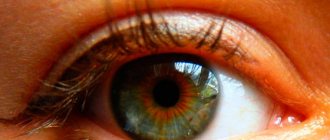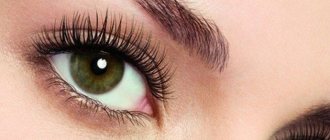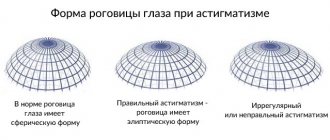Causes of cholesterol plaques on the eyelids
Modern medicine does not know the exact reasons for the formation of cholesterol plaques on the eyelids. It is known that the main reason for the formation of these phenomena is impaired metabolism and fat in the human body. Based on this, local fat deposits are formed in the superficial papillary layer of the epidermis.
Quite often, such phenomena occur in people who suffer from diabetes, obesity and disorders of the endocrine system.
Among other common factors and causes of the appearance and formation of cholesterol plaques on the eyelids, the following can be noted:
- Metabolic disorders;
- Obesity;
- Daily poor nutrition;
- Minimum daily mobility;
- Hereditary factor;
- Malfunction of the liver.
So, the accumulation of cholesterol on the eyelids can be observed in people with liver cirrhosis, pancreatitis, lipoid nephrosis and myxedema.
The most common cause of plaque formation is obesity. Excess weight is a consequence of metabolic disorders, as well as consumption of large amounts of animal fat. If a person consumes little plant food, if vitamins do not enter the body, he will not have time to process the incoming compounds, but will constantly put them aside in reserve. All this automatically leads to the accumulation of cholesterol in the form of plaques on the blood vessels and eyelids.
Causes of pathology
Cholesterol plaques in the eyes are formed due to impaired metabolism of fats in the body with their subsequent deposition in the upper layer of the skin.
The main reasons causing the development of defects on the eyelids:
- genetic predisposition;
- endocrine pathologies - diabetes mellitus, myxedema;
- liver diseases of a severe nature;
- disorders of the urinary system - nephrosis;
- avitaminosis;
- failures of the cardiovascular system.
Additional factors influencing the appearance of tumors:
Heavy food contributes to the appearance of such formations.
- overweight, obesity;
- low physical activity and mobility;
- unbalanced diet, eating large amounts of food that is difficult to digest;
- age-related changes and aging of the body - with age, the likelihood of defects increasing.
Symptoms and signs
Cholesterol plaques on the eyelids are raised yellow plaques that are located on the upper parts of the eye. They are completely painless when pressed and palpated, and are characterized by a soft consistency.
Formations can also be observed on both eyelids, that is, they can be multiple rather than single. If there are many such formations, they begin to merge, forming continuous lumpy elements and stripes with uneven edges that run across the entire eyelid.
The development of plaques on the eyelids begins suddenly; no preliminary changes in the skin of the eyelids are observed. The development process is quite slow, the patient does not experience any unpleasant phenomena.
Among the main characteristic features inherent in these formations are:
- Size – from pea to bean;
- Never transforms into cancer;
- Multiple formations represent a serious cosmetic defect;
- The formations do not completely disappear on their own, and in the absence of treatment their number increases.
Occasionally, cholesterol plaques are observed in children. The cause may be a hereditary factor, as well as a malfunction of the liver, heart and blood vessels. Children and adults are required to have a competent consultation with an endocrinologist and dermatologist.
There are no difficulties in establishing a diagnosis, since cholesterol plaques are visible. During the examination, doctors use special medical glass, which applies pressure to the formation. Such pressure bleeds it and the presence of a yellow formation can be clearly seen.
During the diagnostic process, the specialist must conduct a thorough study of fat metabolism in the body, that is, determining the amount of cholesterol and the total volume of lipoproteins.
In special situations, a study is carried out with syringoma and the presence of tumor formations of the epidermis is excluded.
Prevention
To prevent the formation of cholesterol plaques in the eyes, you must adhere to the following basic rules:
- Eat properly and balanced.
- Spend more time outdoors.
- Enough to move throughout the day.
- Eliminate bad habits.
If you have concomitant diseases, it is important to monitor your health status and promptly consult a doctor for diagnosis and treatment. Preventive measures include careful care of the skin around the eyes and the use of high-quality and hypoallergenic products to cleanse the area around the eyes.
Treatment - basic rules
Cholesterol plaques on the eyelids do not have a clear, targeted treatment. If formations appear, treat
you need a reason, that is, to eliminate problems and malfunctions in the functioning of vital organs, get rid of excess weight and disorders of fat metabolism in the body. In the latter case, the doctor prescribes thyroidin and insulin.
If the patient clearly has a violation of the lipid composition of the blood or a significant increase in cholesterol, it will be necessary to follow a certain diet. Its main rule is to replace animal fats with vegetable ones.
Patients with these cholesterol formations are prescribed medications aimed at reducing total cholesterol levels in the blood:
- Parmidine;
- Cytamifene;
- Linetol;
- Clofibrate;
- Lipamide;
- Dioponin and so on.
As a supplement, various herbal preparations and treatment regimens with effective folk remedies are prescribed. Special supporting drugs are prescribed - ascorbic acid, as well as nicotinic acid, calcium, essentiale, choline chloride.
Important! Medicines and folk remedies must be prescribed by a specialist, since all drugs are characterized by different side effects, which must be taken into account in order to avoid various dangerous complications.
Proper treatment will help restore the body’s functioning, but will not remove existing plaques. The presence of formations can only be removed surgically. This is an ideal method to eliminate all unpleasant cosmetic defects.
Excision is carried out using different methods:
- Laser exposure;
- Electrocoagulation;
- Cryotherapy;
- Destruction.
The process is performed under local slight anesthesia; hospital treatment is not required. If the formations have a wide base, removal occurs through diothermocoagulation. If the formation is combined with a drooping eyelid, surgical excision of the formation is performed simultaneously with the removal of excess skin on the eyelids.
The edges of the resulting wounds are brought together and treated with iron sesquichloride, due to which a fairly strong healing scab is formed at the site of removal. It allows the wound to completely heal due to the initial unattractive tension in about a week and a half.
Causes and symptoms of xanthelasma of the eyelids
The results of medical research suggest that the appearance of this neoplasm is caused by a malfunction in lipid metabolism. A comprehensive diagnosis of the owners of such plaques most often reveals pancreatitis, diabetes mellitus, liver disease and other diseases associated with increased cholesterol levels in the blood. This condition primarily affects women aged 50 years and older, although men can also develop it if they have certain health problems.
The neoplasm appears on the skin in the form of a small yellowish nodule, reminiscent of an ordinary wen. Then this nodule begins to grow and seems to “spread” across the eyelid, forming a flat plaque. The growth can be single or be a cluster of several plaques located on the lower and upper eyelids.
The formation of xanthelasmas is not accompanied by tissue inflammation or pain. There is also no risk of these tumors degenerating into malignant ones. Therefore, the unaesthetic appearance of eyelids affected by the disease most often becomes the main reason for visiting a cosmetology clinic.
Treatment with traditional methods
As an effective treatment for cholesterol plaques on the eyelids, doctors prescribe various herbal infusions. Such therapy may take a little longer than usual, but it gives a fairly strong and lasting effect.
Here are some of the most effective recipes with which you can quickly restore the body’s functioning and completely prevent the appearance of new cholesterol formations:
- You will need to take 100 grams of rose hips, the same amount of mint and 75 grams of immortelle. Everything is thorough
mixed, crushed. To prepare a medicinal infusion, you need to take 3 spoons of the resulting mixture, pour them with three glasses of water. The composition is brought to a boil, boiled for about a minute and infused for 3 hours. The composition is taken in 150 ml doses approximately 4 times 30 minutes before meals. Treatment lasts at least 60 days, and to fully consolidate the result, you need to repeat the course of treatment after a month. - Yarrow. Two teaspoons of herbs are steamed with a glass of boiling water. Everything is infused for about an hour. After this, the product can be filtered and taken one-fourth of a glass three times before meals. Dill infusion. You need to take a spoonful of dill - fresh or dry. Pour a liter of boiling water into a thermos and leave for 30 minutes. The resulting mixture is drunk throughout the day, usually after a week the formations decrease in size, but do not go away completely. This treatment method is not prescribed for heart disease!
- Treatment with hellebore. You will need to take 50 grams of pre-chopped hellebore root. The raw material is filled with a quarter glass of water. Before use, the infusion must be infused for 12 hours. The resulting infusion is drunk once a day and immediately. The average course of treatment is a year.
- Shiitake mushrooms. Raw materials in the quantity recommended by the doctor are filled with alcohol or vodka and infused for a week. After straining, the infusion is taken one tablespoon once a day. This remedy gives a slight laxative effect, since the digestive system and the entire body are cleansed very quickly with this treatment. The general course of treatment here is also one year.
- Oregano. You need to take a spoonful of oregano in a glass of water or even milk. The composition is boiled for a couple of minutes, after which it is carefully wrapped and infused for 12 hours. The product is taken for three weeks, approximately one third of a glass three times a day.
- Cinnamon is an optimal remedy for cholesterol formations and fatty deposits on the body. To completely get rid of tumors, you should eat a tablespoon of cinnamon every day.
These are effective folk remedies that, with a competent approach and following the recommendations of a specialist, give a quick positive result. A higher effect can be achieved with simultaneous treatment with modern medications and using various lotions and compresses.
Cholesterol plaques on the eyelids - how can you get rid of them?
Cholesterol, when the metabolism of fats in the body is disturbed, accumulates, forming deposits not only on the inner membranes of blood vessels, but also under the skin, and the face often becomes the place of localization.
Cholesterol plaques over the eyelids are commonly called xanthelasmas. Being benign neoplasms, xanthelasmas do not cause pain and do not bother the patient in any way, but they noticeably disfigure the face, which cannot but bother women. There may be several of them, and if they occur, urgent measures must be taken.
The operation remains a reliable and proven method for removing plaques, but you need to understand that the manipulation requires the use of anesthesia, and the postoperative wound requires careful care. In addition, even after an operation of impeccable quality, a small seam remains, but absolutely all neoplasms are removed, and the appearance of new ones is minimized.
Removal can be done microsurgically, and the scar will be much smaller, but the cost of such an operation increases significantly.
The surgical procedure is quite simple: through a small incision, the plaque is separated from the vessels feeding it and removed, and the wound is sutured.
Diet and lifestyle changes
Cholesterol enters the body with food, so the importance of diet cannot be overestimated. Fresh fruits and vegetables, cereals and cereals, seeds and nuts will help in the fight against cholesterol. Fish and meat are not excluded, but they must be lean. It is better to replace fatty fish with red fish, rich in omega 3 acids. You can eat boiled eggs.
Animal fats should be replaced with vegetable oil. The amount of salt has been reduced. Eating should be in small portions several times a day.
The following foods are strictly prohibited:
- fatty pork and lamb;
- semi-finished products and fast food;
- butter and margarine;
- baked goods and carbonated drinks.
Garlic deserves special mention, as it not only helps the immune system, but also protects the walls of blood vessels from layers of harmful fat.
To help with the diet, moderate exercise and sports are recommended.
Features of drug therapy
Since the formation of cholesterol deposits is provoked by obesity and metabolic failure, drug therapy is designed to combat these phenomena: normalize metabolism and cure gastrointestinal diseases.
The doctor prescribes drugs to lower blood cholesterol (statins, fibrates), medications for the liver and vitamins.
Additionally, infusions and decoctions of medicinal plants are recommended, and the plaque can be lubricated with absorbable ointments that will smooth the skin and remove the postoperative scar.
ethnoscience
There are medicinal plants with targeted action that successfully fight cholesterol deposits both from the inside, when taken orally, and externally, when lubricating the growth under the skin.
Fenugreek Seeds to Remove Cholesterol Plaques Under Eyes
To completely eliminate unpleasant deposits, fenugreek seeds are used, which can be used in combination as an internal and external remedy:
- Two teaspoons of seeds are soaked overnight in a glass of water and taken daily on an empty stomach.
- The seeds are infused overnight in water, which is rubbed into the affected area of skin every morning.
Xanthelasmas are removed in a natural, harmless way, not too quickly, but very successfully. The course of treatment lasts at least 4 months.
Castor oil for the treatment of xanthelasma
Castor oil contains ricinoleic acid, which is good at removing small, young cholesterol formations. A cotton pad is soaked in pure castor oil and applied to the affected area. After a short massage, allowing the oil to be absorbed into the skin, the disc is secured to the xanthelasma and left overnight. The simple procedure is repeated every evening.
A few cloves of garlic on an empty stomach are an excellent alternative to medications, harmless and very healthy. Garlic is not only used internally - garlic compresses have gained popularity due to their ease of preparation and effectiveness.
Making a garlic dressing for topical use is quite easy:
- Chop or crush the cloves to a paste.
- Apply to the affected area, cover with gauze to prevent the juice from getting into your eyes.
- Leave for about 15 minutes and rinse with warm water.
- Repeat once for several days in a row.
A contraindication to the use of garlic can only be very sensitive skin, which will react to the burning phytoncides of the plant. Before starting procedures, it is advisable to consult a doctor.
Using Apple Cider Vinegar
The acid in apple cider vinegar successfully dissolves cholesterol deposits and helps the liver remove toxins from the body. Vinegar can be used internally and as an external remedy, diluting it with water. Preparing the medicine is not difficult:
- A tablespoon of vinegar is mixed in a glass of water with honey and taken twice a day.
- A cotton swab soaked in vinegar is held on the affected area for two hours
To avoid burning your skin, vinegar must be diluted with water. The results of simple treatment will be noticeable within a few days.
Warm masks
Accelerated blood flow in the vessels prevents the formation of plaques, so warm masks that dilate blood vessels are used to combat cholesterol. You can choose a mask with essential oils; its temperature should remain between +30°C and +40°C to avoid burns.
The area around the eyes is very sensitive and vulnerable, so before using the procedure, consultation with a doctor is required.
Almonds to remove cholesterol deposits around the eyes
The beneficial properties of almonds have been known for a long time, and its ability to lower cholesterol levels has been proven by scientists. A diet containing almonds reduces the risk of heart disease.
Almonds soaked in water overnight can be eaten in the morning for breakfast. It is useful to apply a nut ground into powder and mixed with milk (1 teaspoon) daily to the sore spot and wash it off after drying.
Using Orange Juice to Remove Cholesterol Deposits Around the Eyes
The simplest, most delicious and inexpensive, but at the same time quite effective way to fight cholesterol! You need to drink several glasses of fresh juice a day, or replace them with the fruit itself. The work will be carried out by flavonoids, folic acid and vitamin C.
Cryodestruction
This method involves the targeted destruction of plaques with cold, which destroys xanthelasma tissue, sending cholesterol into the bloodstream. If the plaque is small, one procedure will be sufficient, taking no more than half an hour.
The good thing about this method is that it is carried out without anesthesia or pain relief and leaves no traces. However, it is contraindicated in the presence of infection or eye disease. Cryodestruction is not used in people under 20 years of age.
Liquid nitrogen is used during the procedure, so there is a risk of hypothermia. By acting on the plaque, nitrogen freezes its tissue, which dies after thawing. A scab remains at the site of the tumor. The treatment ends with the falling off of this scab.
Laser irradiation
Compared to freezing, laser exposure is safer for the patient. The plaque tissue is exposed to high frequency waves, causing a resonance that destroys xanthelasma. Cholesterol is gradually released into the blood, and the eyelids acquire a normal appearance.
Laser irradiation does not require pain relief and leaves no traces. The procedure lasts no longer than 20 minutes. After it, the risk of complications is quite low.
The disadvantages of the laser method are minimal:
- Contraindicated in patients with metal implants.
- Possible eye irritation.
- Eyelid care is required to prevent scar tissue from appearing.
Whatever the doctor’s chosen method for removing cholesterol deposits, it alone will not be enough to get rid of xanthelasma forever. From now on, the patient must strictly monitor his health and follow all the doctor’s instructions, because the very appearance of plaques on the eyelids indicates serious problems in the body.
Source: https://expertpososudam.ru/profilaktika/blyashki-na-vekakh-glaz-kak-izbavitsya.html
External means
Many different effective recipes are used as local therapy. Among the most effective and efficient are the following:
- You can use 1% mercury or ichthyol ointment. Used twice a day for a couple of weeks;
- Many people use honey dough. To prepare, you need to take a spoon of any type of flour, honey and an egg. All components are mixed until you get a soft and non-spreading dough in your hands. It can be applied to the eyelids for about 10 minutes every other day. Residues from the eyelids are washed off simply with water without using soap;
- 0.5% hydrocoptisone ointment is useful. It is applied to the eyelid a couple of times during the day. The total treatment time is three weeks. This drug ideally smoothes out scars that form after surgery.
In the process of treatment with these drugs, such points as preliminary consultation with a specialist, long-term treatment and consistency are important.
How to remove cholesterol plaques under the eyes, on the eyelids: treatment and removal
A white rash on the edge of the eyelid, below or above may be caused by cholesterol. It looks like little balls that contain white fat under the skin. Cholesterol plaques on the eyelids usually start as one lump that grows.
After a while they become clusters of plaques. Cholesterol plaques under the eyes are caused by high levels of LDL and triglycerides and genetic reasons.
Only lifestyle and dietary changes can help get rid of cholesterol plaques under the eyes.
Treatment of cholesterol deposits under the eyes
Xanthelasma is a result of fatty deposits that accumulate around the eyes. It can occur in people of all ages, but is most common in middle-aged and elderly people.
Xanthelasmas are usually not painful, but they can become progressively worse and cause great discomfort if left untreated. If the cause is dyslipidemia, it can lead to more serious problems over time.
In fact, one study found a link between xanthelasma and heart disease and severe atherosclerosis.
There are various procedures and treatments that a doctor can use to remove cholesterol plaques and under the eyes. He may also recommend lifestyle changes to control your blood cholesterol.
Surgical method
How to remove cholesterol plaques under the eyes? Your doctor may prescribe removal of cholesterol plaques under your eyes. There are several methods that doctors use:
- Surgery - excision using a very small blade is usually the first option to remove one of these growths. Recovery is at least four weeks.
- Chemical cauterization uses chlorinated acetic acids and can remove plaque without leaving many scratches.
- Cryotherapy used repeatedly can destroy the plaque. This carries the risk of scarring and changes in skin pigment.
- Removal using carbon dioxide and argon laser is less invasive than surgery and has reasonable success rates. This carries the risk of pigmentary changes.
- Electrodeposition can be used with cryotherapy.
For any procedure, it is important to track your recovery by getting rid of plaques.
Pay attention to any side effects you experience and tell your doctor at your next appointment. Xanthelasma has a high recurrence rate, especially in cases of surgical excision or severe hyperlipidemia.
Castor oil for the treatment of Xanthelama
Using castor oil is another effective remedy for removing cholesterol plaques around the eyes. It helps shrink cholesterol plaques due to the presence of ricinoleic acid. However, this oil works best on small plaques that are new.
Diet and healthy lifestyle
Proper nutrition is the basis for treating excess total dangerous cholesterol. You need to include as many vegetables and a wide variety of seasonal fruits into your diet. Eating animal fats, cakes and sweets, that is, carbohydrates and spicy foods, should be reduced! If there are formations on the eyelids, it is strongly recommended to give up smoking and alcohol.
Basic nutritional rules include:
- Transition to 5 meals a day;
- Each meal should contain no more than a teaspoon of fat. It is necessary in small quantities, as it is responsible for the removal of bile from the liver into the intestines;
- It is important to drink up to 2 liters of water per day;
- In the diet of every person suffering from cholesterol formations, the norm for an adult should not be more than 25 grams of edible butter, and 75 grams of vegetable butter per day.
Along with the diet, it is important to lead the best possible lifestyle. Serious sports should be done twice every seven days, and every day you should take short walks and morning exercises. With constant, even minimal physical activity, metabolic beneficial processes are immediately activated.
The essence of eliminating the problem is that every person needs a certain amount of energy, which he gets from food. With an active lifestyle, calories will not be stored in the body in the form of fat folds. At the same time, exercise and certain activities allow lipoproteins to circulate throughout the body much faster; they simply will not linger and accumulate in certain places.
Important! Treatment and lifestyle changes in the presence of cholesterol plaques on the eyelids cannot be delayed! The presence of such formations indicates that the arteries in the body are clogged, causing the blood supply to the organs to be severely impaired. All this not only reduces overall vitality, but is a serious danger to life.
Cholesterol plaques on the eyelids – xanthelasmas: photos, how to get rid of them
Xanthelasmas or cholesterol plaques on the eyelids indicate a severe disorder of lipid metabolism. Fatty plaques are not only a cosmetic defect, but also an “alarm signal” for the patient.
Causes
The exact cause of xanthelasma has not been established. The basis for cholesterol deposits in the papillary layer of the epidermis is a gross violation of fat metabolism.
Plaques on the eyelids are often observed in patients with uncontrolled diabetes mellitus, excess body weight, and thyroid dysfunction.
Lipid metabolism disorders arise from:
- smoking;
- poor nutrition;
- physical inactivity;
- genetic predisposition;
- liver diseases;
- excess body weight.
Hepatitis of various etiologies manifests itself with the appearance of xanthelasmas. Dysfunction of hepatocytes leads to impaired utilization of excess cholesterol, which is deposited on the walls of blood vessels, under the skin of the eyelids.
Symptoms
Xanthelasmas are painless, soft, yellow formations located under the skin of the eyelids. They can be single or multiple. Lack of treatment leads to the formation of confluent cholesterol lesions. Large xanthelasmas present an ophthalmological problem: it is difficult for the patient to open or close the eyes.
Xanthelasma before/after removal.
The formation of a cholesterol plaque goes through a long stage, and the patient does not experience discomfort.
The characteristic signs of xanthelasma are:
- diameter from 1 to 10 cm;
- do not degenerate into cancerous tumors;
- drainage formations – ophthalmological or cosmetic defect;
- do not disappear on their own and progress without treatment.
Cholesterol plaques on the face rarely appear in children. The reason for this is a genetic factor, heart defects, severe liver pathologies. For diagnosis, the doctor performs dermatoscopy.
Using a magnifying glass, the doctor evaluates the density, blood vessels, and nature of the tumor. It is also necessary to assess the state of lipid metabolism using a biochemical blood test.
Increased levels of total cholesterol, low-density lipoproteins, very low-density lipoproteins, and triglycerides indicate systemic pathology.
Differential diagnosis is carried out with syringoma, atheroma, lipoma, basal cell carcinoma. The most accurate research method is histology. In the biopsy material, the morphologist evaluates the nature of the cells and also looks for signs of malignant neoplasms.
Principles of treatment
Treatment of cholesterol formations under the skin requires an integrated approach. Treatment involves mandatory getting rid of excess body weight and normalizing cholesterol metabolism. A balanced diet is the first step in the fight against excess weight and lipid metabolism disorders. The patient is prescribed a dairy-vegetable diet with a reduced content of animal fat.
If diet therapy is ineffective, they switch to drug treatment. The following groups of drugs are used to lower cholesterol levels:
- statins: Atorvastatin, Simvastatin, Rosuvastatin;
- fibrates: Clofibrate, Bezamidine, Atromid;
- bile acid sequestrants: Cholestyramine;
- nicotinic acid, its derivatives;
- Omega-3 fatty acids.
All groups of drugs are prescribed exclusively by the attending physician. Illiterate use leads to serious side effects. For example, an overdose of statins can lead to muscle necrosis.
A systematic approach normalizes impaired metabolism and stops the progression of xanthelasma. However, the formed plaques do not disappear on their own. For complete elimination, cholesterol plaques on the eyelids are removed using minimally invasive surgical methods.
These methods include:
- laser excision;
- electrocoagulation;
- cryodestruction;
- radio wave removal;
- classic removal with a scalpel.
Removal is carried out under local anesthesia on an outpatient basis. Small formations are removed by diathermocoagulation. Large xanthelasmas are removed using the classical surgical method. The wound is closed and treated with iron sesquichloride. Due to the dense scab, the defect heals quickly. Prevention of new formations includes proper nutrition and medication support.
Products for external use
Topical treatments for xanthelasma are not as effective as surgical excision. However, their use stops the progression of the disease. The use of local agents in the postoperative period promotes rapid healing of wounds without scarring.
Local drugs to combat cholesterol plaques:
- Ichthyol ointment. Lubricate the formations 2 times a day for 14 days. Do not apply to open wounds.
- Vishnevsky's liniment. Apply 1 time/day, before bedtime.
- Propolis. Apply a piece of propolis to the plaque and secure with a band-aid. Leave overnight. Repeat every day for 2 weeks.
- Hydrocortisone ointment. Apply 2 times/day. It relieves inflammation and itching well.
- Contratubeks. Apply the gel according to the instructions. With regular use, it eliminates post-operative scars.
Folk remedies
Herbal medicine is an effective method for correcting lipid metabolism. A course of treatment with infusions of medicinal herbs stops the growth of existing xanthelasmas and also prevents the formation of new ones.
Effective recipes to combat plaques under the skin:
- Herbal collection. Ingredients: 75 grams of immortelle flowers, 100 grams of rose hips, peppermint. Grind all ingredients in a coffee grinder. Pour 3 tablespoons of the resulting powder into half a liter of water. Boil the solution. Leave for 4 hours. Take 100 ml 3-4 times a day half an hour before meals. The course of treatment is 2 months.
- Fenugreek seeds. Chew 1 teaspoon of seeds on an empty stomach. Treatment lasts 4-5 months.
- Yarrow herb. Grind the plant materials in a blender. Pour 10-15 grams of powder into a glass of hot water. Leave for 45 minutes. Strain the solution through cheesecloth and use throughout the day. The medicine should be taken before meals. The course of treatment is 2 months.
- Dill water. Both fresh and dry dill are suitable for cooking. A spoonful of crushed plant material is poured with boiling water (1 liter) and left for half an hour. The resulting solution is drunk in one day. Drink dill water every day. Course – 1 month.
- Hellebore infusion. 50 grams of plant root are ground in a coffee grinder. Pour the resulting powder into a glass of water. The solution must be infused for at least 10 hours in a cool, dark place. Take the infusion daily, drinking immediately. The course of therapy lasts from 6 to 12 months.
- Shiitake mushroom tincture. The eastern symbol of longevity contains a unique substance - eritadenine, which has proven effectiveness in the fight against xanthelasma. 50 grams of mushrooms are poured with half a liter of vodka. Leave for about a week in a dark bottle. After 7 days, the tincture is filtered with gauze. Take the drug 15 ml 1 time/day. The course of treatment is 1 year.
- Oregano. A tablespoon of herb is poured into a glass of water. The solution is boiled for 2 minutes, left to infuse for 12 hours. Take the infusion for a month, 50 ml/day.
- Cinnamon. Pour hot water over a cinnamon stick, a slice of lemon, and a sprig of mint. After cooling, add a spoonful of honey. You can drink this tea every day.
- Propolis tincture. Dilute 1 teaspoon of the prepared tincture with a glass of water. Drink on an empty stomach half an hour before breakfast. Repeat daily for a month.
Herbal medicine improves the patient's condition and can stop the development of skin lesions.
Diet, proper lifestyle
Therapeutic and prophylactic diet helps reduce body weight and improve metabolism. Patients with xanthelasma against the background of atherosclerosis are prescribed table No. 10-C according to Pevzner.
Goal of diet therapy:
- slowing the progression of atherosclerosis;
- prevention of the appearance of new xanthelasmas;
- correction of lipid metabolism;
- normalization of systemic circulation, capillary blood flow of the eyelids;
- elimination of obesity;
- providing nutrients to the cardiovascular system, kidneys, and liver.
General characteristics of the diet for xanthelasma:
- animal fat is replaced with vegetable fat;
- the amount of quickly digestible carbohydrates is reduced to zero;
- proteins in accordance with physiological needs (1-1.5 grams/kg body weight);
- limit table salt, extractive substances (broths);
- increase the intake of magnesium salts, ascorbic acid, B vitamins, coarse fiber;
- meals should be frequent, but small in volume;
- drinking regimen: 30 ml/kg body weight;
- maximum vegetable fats per day – 80 grams, animal fats – 30.
Physical activity increases the breakdown of lipids in the blood. Dynamic exercise requires a lot of calories. The heart rate increases, and the consumption of adipose tissue for energy purposes is activated.
Daily 30-minute walking reduces the risk of progression of atherosclerosis by 40%. It is advisable to supplement your walks with training in the gym, swimming, and aerobics.
You should exercise for 40 minutes 2 times a week.
Conclusion
Xanthelasma is a cosmetic defect. Drain formations require surgical intervention to prevent vision problems. The appearance of cholesterol plaques on the eyelids indicates serious “contamination” of arterial vessels with lipids. Xanthelasma can be completely eliminated only through surgery.
Literature
- Andrew A Dahl, MD, FACS. Xanthelasma, 2017
- Nancy Fitzgerald. What Is Xanthelasma? 2017
- Zainab Laftah, Firas Al-Niaimi. Xanthelasma: An Update on Treatment Modalities, 2018
Last updated: February 1, 2020
Source: https://sosudy.info/holesterinovye-blyashki-na-vekah
Summing up
Cholesterol plaques on the eyelids do not cause harm to human health; they are a consequence of already existing disorders and a certain cosmetic defect. It is possible to improve the functioning of the body and prevent the appearance of new formations only through competent treatment, a proper and active lifestyle, as well as proper nutrition.
You should always remember that even the simplest treatment must be carried out under the supervision of a specialist; this is a guaranteed opportunity to solve all your problems, maintain your health and attractive appearance for a long time.
Treatment of pathology
A person with such a problem should eat more plant foods.
To get rid of cholesterol plaques in the eyes, the harmful effects of provoking factors are eliminated and therapy is carried out for the disease of the body that caused metabolic disorders. Main methods of treatment:
- dietary nutrition, emphasis in eating on plant foods, proteins, vitamins;
- healthy lifestyle;
- medicines for external use;
- preparations for internal use;
- surgical methods of exposure.
Medicines are used to target cholesterol plaques. The dosage regimen and methods of use are prescribed by the attending physician depending on the extent of the skin lesion, the general health of the patient and the causes of the pathology. The main treatments are described in the table:
| Drugs | Impact |
| External use | |
| Ichthyol ointment | Regenerates |
| Disinfects | |
| Improves microcirculation | |
| Dries out | |
| Zinc ointment | Softens and protects skin |
| Disinfects | |
| Absorbs moisture and dries | |
| Internal use | |
| Statins | Break down fats |
| Normalizes digestion | |
| Improve blood properties | |
| Bile acid sequestrants | Removes cholesterol |
| Promotes the accumulation of nutrients | |
| Fibrates | Prevents the deposition of cholesterol on the walls of blood vessels |
| Stimulate and correct metabolism | |
| Prevents blood clotting | |
| A nicotinic acid | Improves metabolism |
| Stimulates blood circulation | |
| Replenishes vitamin deficiency | |
| Hepatoprotectors | Protect liver cells |
Formations can be removed from the skin using laser technology.
To completely remove cholesterol plaques, the following surgical methods are used:
- Cryodestruction - exposure to low temperatures.
- Laser removal - burning with a laser beam.
- Electrocoagulation - elimination of defects with high frequency current.
- Surgical intervention - cutting with a scalpel.
